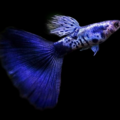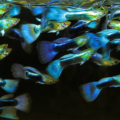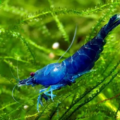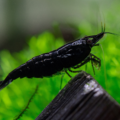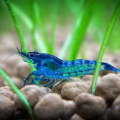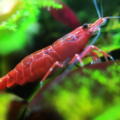Use all the expert tips in this Bloody Mary Shrimp Care guide to maintain a vibrant, healthy shrimp aquarium.

Introduction
What’s radiant and destined to elevate your aquarium’s appearance? That’s right, the Blood Mary Shrimp!
This red Neocaridina shrimp (Neocaridina davidi) is a jewel among freshwater shrimp species. Its rare, deep crimson color gives it a unique and bold look in any aquarium. If you’re deep in your aesthetics bag and need a wow factor in your home tank, this red beauty is a sure bet.
However, Blood Mary shrimps are more than just their rich color. These aquatic beauties and members of the Neocaridina genus often exhibit extreme sturdiness and perseverance in the face of harsh water conditions, thus making them the most suitable freshwater shrimp for beginners on their aquatic hobbiyist journey.
We’re not even halfway into the irresistible world of this shrimp. Be sure to read our Bloody Mary Shrimp care section because this is how to ensure your pet stays captivating and active throughout their lifespan.
Appearance and Characteristics

The vibrant red color of this beauty is a wonder of nature, but there’s an explanation behind it, and we’ll help you understand it.
The vivid, deep, translucent red color pattern of the Blood Mary Shrimp results from selective breeding, which is mainly responsible for the color variations in Neocaridina shrimps. This selective breeding involves mating shrimps with the most vibrant and consistent red hues to stabilize the deep red trait in the Blood Mary species.
The color intensity of this red freshwater shrimp is influenced by various factors, especially diet and tank condition. This shrimp can grow up to a maximum length of 2 inches.
Side Note: Their translucent exoskeleton gives you a full view of the bright red tissue underneath their bodies.
Aside from the stunning Bloody Mary Shrimp’s appearance that instantly commands attention, their warm personality is another endearing feature of these shrimps. Neocaridina shrimp are very sociable animals that co-exist peacefully with different tank mates in an community tank.
Tank Requirements

Bloody Mary Shrimp are captive-bred, which means they don’t necessarily have a natural habitat. Nevertheless, their history traces their origin back to the lakes and streams of Taiwan, which means whatever you add to their tank should try to mimic their natural environment.
The best tank conditions for shrimp include clean water and natural plants like Java Moss. A Bloody Mary Shrimp tank setup should also include a hiding spot such as driftwood or decor with caves for shelter so your shrimp has a place to retreat after molting.
Freshwater shrimp water parameters are another area you must never ignore. This includes maintaining a pH balance of 6.0-7.8 in freshwater with the ideal temperature range of 64-840F. The minimum tank size for a shrimp must be 7-10 gallons; that way, the shrimp can swim comfortably and breed with ease.
Side Note: Using a dark substrate helps with color enhancement by creating a sharp contrast between the red shrimp color and the dark appearance of the sand/gravel, which may also mimic the natural environment typical in lakes and streams.
Feeding Bloody Mary Shrimp

Now, it’s time to delve into the world of what these beauties eat; here’s all you need to know about the Bloody Mary Shrimp feeding.
Your soon-to-be favorite Bloody Mary Shrimp are known as omnivores, meaning their diet consists of both meat and plants, which include algae wafers, shrimp-specific pellets, and blanched vegetables like spinach and zucchini.
For more on feeding your aquatic pets check out The Ultimate Guide to Fish Food: Pros and Cons & Best Choices!
They also graze on biofilm detritus in the tank, cleaning the tank while getting their required nutrient quota—see why they’re beginner-friendly—nothing goes to waste around them!
We recommend feeding them their omnivorous shrimp diet 1-2 times daily to prevent overfeeding and removing uneaten food in tanks to prevent water pollution. The best diet for freshwater shrimp is varied, as listed above, to help these red beauties maintain their famous vibrant color.
Breeding Bloody Mary Shrimp
Bloody Mary shrimp breeding is one of the rewarding aspects of keeping these Neocaridina species because they are prolific breeders!
They become sexually mature from 4-6 months. You only need one pair to kickstart freshwater shrimp reproduction in a suitable environment with the proper water parameters and enough food sources.
This video has been very helpful in identifying the sex of Neocaridina Shrimp, I highly recommend it:
Females release pheromones during spawning to call on the males, who rigorously chase after the pheromones to mate with the female. The female gets to work by laying eggs and attaching them to her swimmerets. The eggs take up to 2-3 weeks to hatch, after which they begin swimming and searching for food like adult shrimps.
For shrimp breeding care, make sure there are available hiding spots to allow the female shrimp to retreat, if needed, for breeding and ensure the newly hatched shrimp are safe from consumption by larger tank mates. Putting them in a separate tank until they’re mature is the safest way to ensure they reach adulthood.
NOTE: mixing neocaridina shrimp varieties carries the risk of interbreeding different color varieties from the different variants which will result in their offspring not inheriting their parent’s coloration. It is not a terrible thing, but if you hope to pass on the chocolate shrimp’s brown coloration, it is best to do so in a chocolate shrimp only tank. The mixed offspring would instead inherit a wild coloration.
Tank Mates For Bloody Mary Shrimp

Your Bloody Mary shrimp could use some new friends, and you can also boost diversity in your tank by introducing new creatures. We’ll tell you what tank mates are suitable and what tankmates might turn your shrimps into snacks.
Bloody Mary shrimp are sociable and peaceful community shrimp, making them great candidates for freshwater shrimp compatibility in any aquarium.
They do well with small, non-aggressive tank mates who won’t see them as food, which is why it is best to avoid placing them with larger fish that may prey on them. The ideal Bloody Mary Shrimp tank mates include small Tetras, Rasboras, and other shrimp species. Avoid fish like Cichlids and other large predatory species.
Common Health Issues
From parasitic infections to bacterial infections and stress-related problems, the following are some of the common illnesses affecting Bloody Mary shrimp health.
Molting Problems
Cause: Insufficient nutrients in the diet, poor water quality, inconsistent water parameters.
Symptoms: Difficulty shedding shell, lethargy, difficulty swimming
Treatment: Stable water parameters, feeding the shrimp with calcium-rich food to curb molting issues in shrimp, and regular water changes.
Check out Molting Shrimp 101: What to Expect, for more detailed information on avoiding molting problems for your pet shrimp!
Stress
Cause: Overcrowding the tank, poor water conditions, aggressive tank mates
Symptoms: Inactivity, pale coloration, irregular swimming
Treatment: Maintain healthy water parameters, avoid overcrowding, and introduce natural hiding spots for safety.
Sensitivity To Copper
Causes: Copper in tap water and shrimp medication
Symptoms: Lethargy, discoloration or death
Treatment: Regular water change for tap water, filtering out copper with activated carbon, and discontinuing copper-based medication.
Preventative Care for Bloody Mary Shrimp
Freshwater shrimp care tips to help prevent health issues include the following:
- Regular water changes help prevent toxin build-up, keeping the water parameters stable and clean.
- Avoid Copper-based medications, as they are toxic to shrimp. Make sure you check labels before administering any treatment to your shrimp.
- Varied Diet: A balanced diet with high-quality shrimp food, blanched vegetables, and occasional protein sources supports healthy shrimp development.
Water Quality And Maintenance

Maintaining the best water conditions for shrimp is non-negotiable. What does it entail? Find all you need to know right here!
Water Parameters: Keep ammonia and nitrite levels under 0 ppm to keep out toxins. Nitrate levels should stay under 20 ppm as excess nitrates will cause stress and health problems for your shrimps.
Maintenance Routine: Perform weekly 20-30% water changes to keep the water clean and ensure optimum Bloody Mary shrimp water quality while reducing the likelihood of increased toxic levels in your tank.
Filtration Needs: Introduce gentle filters, such as sponge filters, that oxygenate waters without causing too much movement as part of water maintenance for shrimp.
Lifespan of Bloody Mary Shrimp

How long do shrimp live? And how does extending shrimp lifespan work? Ask no more!
The average lifespan of the Bloody Mary Shrimp is 2 years under optimum water parameters and care. Ensure the water conditions are well-maintained, including the pH, ammonia, and nitrate levels.
Extending Bloody Mary shrimp’s lifespan depends on how well you care for this red beauty. Maintain its vibrancy by providing it with a balanced diet, regular water changes, and water temperature control, quarantining any new additions, and providing hiding spots to create a stress-free environment.
Conclusion
Whew! You’re finally here, and we hate to see you go without reminding you of the Bloody Mary shrimp care tips we have discussed so far, including water parameter requirements, treatments, and preventive measures for shrimp illness to help you be the best shrimp keeper in your squad.
Use this freshwater shrimp care guide to create a clean, stable environment with plenty of plants and hiding spots. This will ensure that your beginner-friendly shrimp species thrive and multiply gleefully.

